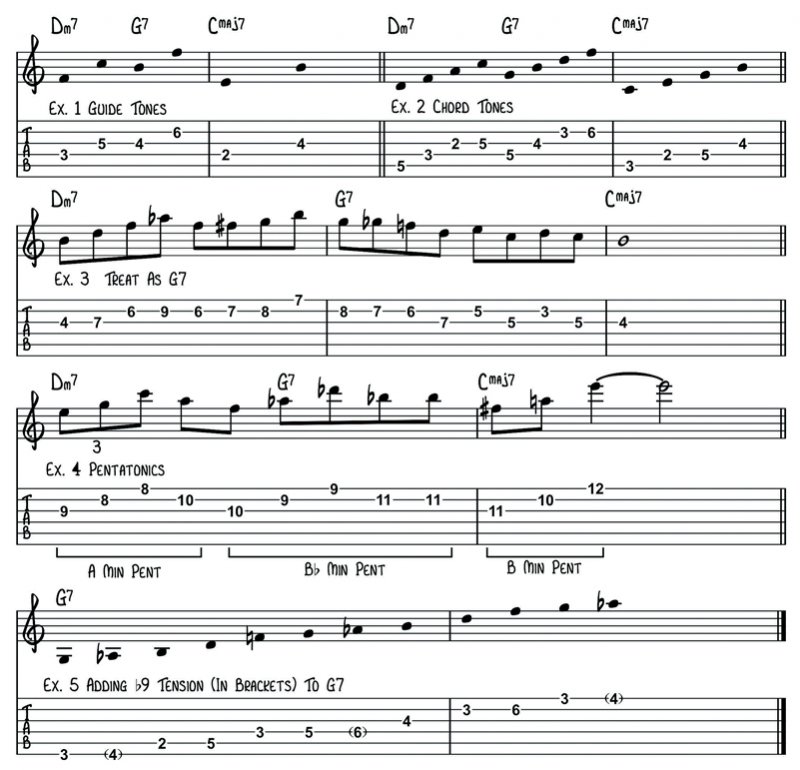Jazz Guitar Shed: The ‘Two Five’ Progression
Jazz Guitar Shed: The ‘Two Five’ Progression
The first thing to remember is that, by definition, a II V I is in one key (i.e. Dm7, G7 and Cmaj7 are in the key of C major). However, beware of just running up and down the C major scale. We want to do more to bring out the detail in the harmony.
Step 1. Target the guide tones (3rds and 7ths) on each of the chords, whilst using C major as a wider source of notes where necessary. See Example 1.
Step 2. Do the same with chord tones (root, 3rd, 5th and 7th of each chord). See Example 2.
For both the above steps, I’ve just written the target notes in one position and octave. Ultimately you want to explore these in all octaves and positions.
Step 3. Ignore the Dm7 chord and treat the whole of the first bar as G7. This will tend to introduce a little more tension, which resolves in bar 2. (You can also try the opposite – treating the first bar as D minor). See Example 3, which also includes approach notes.
Step 4 superimposes pentatonic scales. Solo using A minor pentatonic over Dm7, Bb minor pentatonic over G7, B minor pentatonic over Cmaj7. This will have the effect of introducing considerable tension over the G7, together with the #11 over the Cmaj7. One way of doing this is simply to move a similar motif through each scale (as in example 4).
Step 5 involves altering the G7 to something more than just G7/G9/G13. The G7 chord in this case can have any or all of the following tensions added to it: b5, #5, b9, #9. So you might end up with, for example, a G7#9 chord, or G7b9#5. (What is added will depend on context – the melody, or what the soloist is playing, when you are comping. When you are soloing you have more choices.)
 Experiment with adding each tension individually into the G7 arpeggio (just as if it were an extra chord tone), and solo using this new arpeggio over the G7 chord (just the notes at first, then as targets), until you get to know the sound of the added tension and can use it in the context of the II V I progression.
Experiment with adding each tension individually into the G7 arpeggio (just as if it were an extra chord tone), and solo using this new arpeggio over the G7 chord (just the notes at first, then as targets), until you get to know the sound of the added tension and can use it in the context of the II V I progression.
You might for instance add the b9 (the Ab note) into your G7 arpeggio (see Example 5) and solo from that over the G7 chord. The principle here is to go from what you know already (the sound of G7), and add new sounds one at a time. This gives your ear the opportunity to learn how to use the alterations effectively.
Bonus step. Once you can do all this in the key of C, try it in every other key. You’ll come across II V Is all the time in the standard repertoire, so the more practice you get over them in different keys, the better! Have fun with all this, and if you have any requests for future Jazz Guitar Shed topics, feel free to contact me through the website below.


